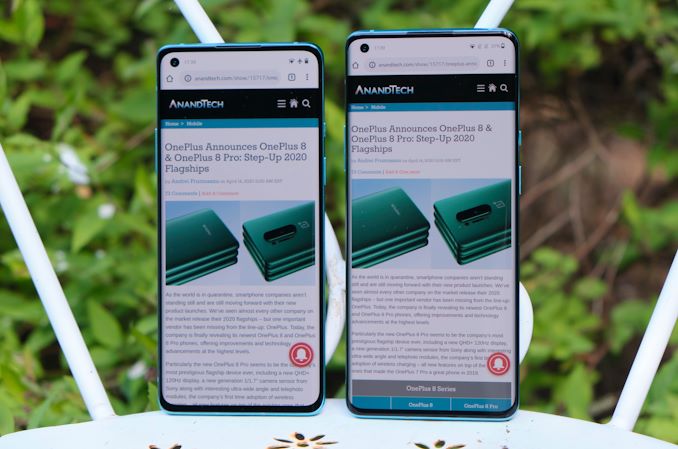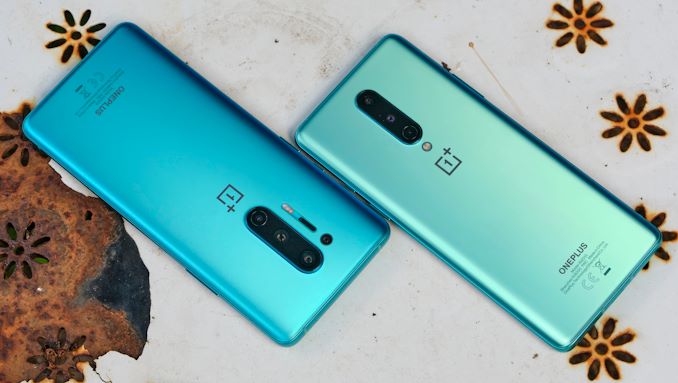The OnePlus 8, OnePlus 8 Pro Review: Becoming The Flagship
by Andrei Frumusanu on June 29, 2020 10:00 AM ESTConclusion & End Remarks
As we’re coming to and end of the review, the biggest question for both the OnePlus 8 and OnePlus 8 Pro is whether they’re devices worth buying.
Design-wise, I really do like what OnePlus has done with both variants. On the OnePlus 8 Pro I’m happy that they dropped the pop-up camera module in favour of a hole-punch front camera setup. Whilst this abandons the seamless full screen experience, the phone is able to gain on internal component spaces that goes to the batteries and cameras and it also gains IP68 certification – all whilst losing weight compared to its predecessor.
I really loved the ergonomics of the smaller OnePlus 8 and this has been easily my favourite form-factor and the best feeling device of the past few years. The symmetrical curves on the front and back glass are a better implementation than the more pronounced display curvature of the OnePlus 8 Pro. We’ve seen other vendors revert on their screen curvature choices and I think OnePlus would also require such a design adjustment in the future.
If you’re opting to get one of the phones – chose one with the matte frosted glass finish. It not only avoids fingerprints a lot better than glossy glass, but it also feels and just looks better. Overall, I think OnePlus did an excellent job on the design of the phones.
The displays of the phones are both fantastic, although obviously the regular OnePlus 8 has lower specifications, going only up to 1080p and 90Hz. The OnePlus 8 Pro’s QHD 120Hz display looks and feels amazing – there’s very little to critique about the phone other than maybe its colour calibration which really wasn’t up to par on my review sample. OnePlus here should spend less on the marketing side and more on the engineering and quality assurance side of things.
Performance of both phones is top-notch, although it’s just in line with other Snapdragon 865 devices. The OnePlus 8 Pro’s 120Hz mode outstanding for scrolling content, and is just second to the S20 series in terms of snappiness. We’ve tested a slew of different new Snapdragon 865 phones recently and they’ve all shared in common excellent GPU sustained performance and thermal characteristics, essentially showcasing no slowdown at all during prolonged usage periods, making the OnePlus 8 and 8 Pro amongst the best Android gaming devices on the market right now.
Battery life was surprising in that the regular OnePlus 8 exceeded our expectations, testing in amongst the longest lasting devices in our mobile suite. The OnePlus 8 Pro’s battery life wasn’t as good – as expected and matching the characteristics of the Galaxy S20 phones, the 120Hz display comes at a great cost to battery life as the software ecosystem just isn’t ready for true variable refresh rate operation.
The OnePlus 8 at 90Hz actually outperformed the OnePlus 8 Pro at 60Hz – and the difference grows to a 32% lead when comparing the two phones in 90Hz vs 120Hz modes. That’s a tough compromise to make given that the smaller phone has a smaller battery – although yes you do get a higher resolution screen and higher refresh rate experience that is indeed noticeable.
On the camera side of things, the regular OnePlus 8 is good – but I wouldn’t quite say it competes quite as well in the flagship segment against the competition. The OnePlus 8 Pro on the other hand easily has a flagship class camera system that not only holds up well with the competition, it even manages to beat them in some aspects such as low-light photography. It’s not a perfect camera system and OnePlus still has to work on their processing, but it’s the best camera experience that the company has ever been able to showcase to date.
In the end, the question of whether the new OnePlus 8 phones are worthy purchases comes down to their prices. Starting with the OnePlus 8 Pro – I think the phone’s starting $/€899 price point the phone easily competes against its closest competitor, that being the S20+. It’s an extremely tough toss-up in almost all aspects of the two phones which is a testament to the fact that the OnePlus 8 Pro is a true flagship device. If you’re in an Exynos market – the OnePlus 8 Pro’s Snapdragon 865 chipset is the obvious choice for better performance and battery life. In the US, the obvious value choice goes to OnePlus again as here we’re still seeing a $300 price gap – with very little compromises in terms of features or quality.
For the OnePlus 8 which starts at $/€699, there’s actually very little competition out there at this price range when what you’re looking for is performance and battery life – as the phone fully delivers and excels on both those aspects. The camera system doesn’t quite match up to an S20 for example, but it also undercuts the S20 by 100€ in Europe. In the US where the S20 is still $999, the differences (QHD screen, 120Hz, wireless charging) between the phones are more easily rationalised by their larger pricing gap.
Overall, I can easily recommend both OnePlus 8 phones – and I don’t think anybody would be disappointed with their purchases. OnePlus was able to produce excellently balanced devices in terms of quality and features as well as their value propositions, and so far, have been a highlight of 2020’s smartphone line-up.












92 Comments
View All Comments
jaju123 - Monday, June 29, 2020 - link
Hi Andrei thanks for the review.Did you encounter the low brightness green tint issue on the OP8 Pro? I haven't seen any mention of it here.
Thanks
Andrei Frumusanu - Monday, June 29, 2020 - link
I didn't have the problem on my device.MrPhilo - Tuesday, June 30, 2020 - link
New update has increased minimum brightness so you would not see it anymore. Installing a custom kernel and changing the brightness to lowest you will see it.Flunk - Monday, June 29, 2020 - link
Sure, if flagship means adding a bunch of pointless features and charging too much for the phone. I think reviewers failing to take value into account in reviews have to take at least some of the blame for these crazy phone prices.Oneplus' quest to make their products irrelevant has now met its totally forseen conclusion.
BedfordTim - Monday, June 29, 2020 - link
It would be nice to see a flagship camera in something like a P30 Lite.close - Tuesday, June 30, 2020 - link
That's kind of what flagship means... Manufacturers bundle the best they have and when they run out of the good stuff they start bundling trinkets, bells, whistles, ribbons... And for most people buying the flagship isn't a matter of need but of want. They have the money, they want the image, even if many of the actual features are superfluous.I think what the title actually means is that OP started up by branding the devices as "flagship killer", the "80% flagship at 20% of the price" so to speak. With OP8 they are now "just" a flagship. As an OP owner I have a hard time justifying 700-1000E for this. That's not to say it's bad but it doesn't stand out of "the pack" (overstatement, I know) of Android flagships.
pjcamp - Tuesday, June 30, 2020 - link
I dunno. I see flagships subtracting options. You can't have expandable storage, you can't have a headphone jack, but you need to pay more to do without those things.s.yu - Wednesday, July 1, 2020 - link
Couldn't agree more!Retycint - Thursday, July 2, 2020 - link
Flagships were never meant to be good value-for-money. Not in the smartphone industry, not in the electronics industry, not ever.eastcoast_pete - Monday, June 29, 2020 - link
Thanks Andrei! I especially appreciate the section and detail on the video performance. However, that leaves me with a question: so, which phone is currently the best for video? It seems that even the so-called flagship models all have significant problems; one has artifacts, the next doesn't do a good job on stabilizing etc. So, which one is currently the leading candidate?